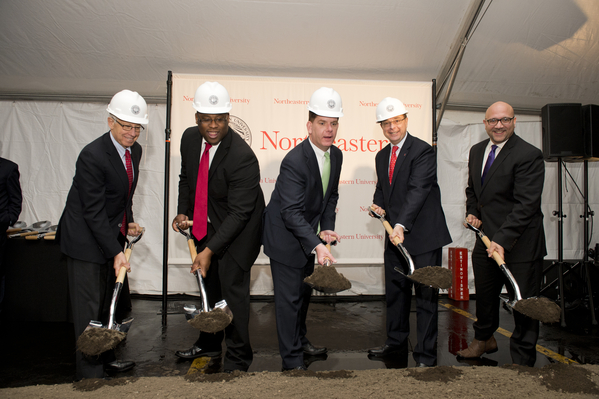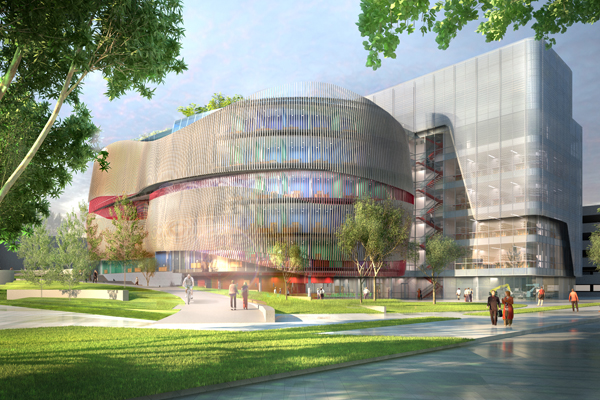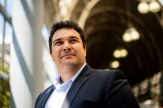Northeastern breaks ground on state-of-the-art science and engineering complex
Northeastern University and the city of Boston opened a new chapter in their long partnership on Friday morning when city officials joined university leaders to break ground on Northeastern’s state-of-the-art Interdisciplinary Science and Engineering Complex on Columbus Avenue.
In his remarks, Northeastern University President Joseph E. Aoun told the hundreds of people in attendance, including Boston Mayor Marty Walsh, Boston City Councilor Tito Jackson, and state Rep. Jeffrey Sanchez of Jamaica Plain, that the new complex would benefit the Northeastern community as well as the entire city.
“You can look at this complex from different perspectives,” Aoun said. “Yes, it is going to serve the students. Yes, it is going to serve our faculty. And yes, it is going to serve the community. But more importantly it is going to bring every constituency together.”
The 220,000-square-foot research and educational space is part of Northeastern’s ongoing effort to expand its capacity to engage in path-breaking research across disciplines. Scheduled to open in 2016, it will include wet and dry lab facilities, educational laboratories, classroom space, and offices for faculty and graduate students.
“A science complex of this scale has the chance to be a shining example of the best Boston has to offer,” Walsh said in his remarks. “This facility will attract some of the world’s best minds in the most cutting edge fields of research. The work they will do will change the world in ways we can’t even imagine yet.”
The ISEC will be the first private research development in Roxbury and is expected to create more than 600 jobs during the construction phase and an additional 700 jobs after the complex opens.
“The future of our university is intimately linked to the well being of the Roxbury community and Boston as a whole,” Aoun said. “You need us. But more importantly, we need you.”

The six-story, LEED-certified facility will feature cutting-edge scientific equipment and lab space, both of which will be shared by researchers from Northeastern’s College of Science, Bouvé College of Health Sciences, College of Engineering, and College of Computer and Information Science.
“The most significant word in the name of this building is interdisciplinary,” Stephen W. Director, provost and senior vice president for academic affairs, said in his remarks. “Our research focuses on finding solutions to the global challenges in the areas of health, sustainability, and security. Solutions to these challenges require the collaboration of many minds working together in many fields.”
Miles Graham, a seventh-grader at the Match Charter Public School in Boston, said the new facility would help Boston youth realize their dreams of becoming successful scientists and engineers. “This new building represents a bigger and better opportunity for Boston’s youth,” he explained. “This is how dreams become real.”
Michael Karolewski, comptroller for the Northeastern Student Government Association, noted that the new complex would offer students more research opportunities than ever before.
“It’s hard to believe, but there will be even more opportunities for students like me to learn in their own disciplines and have the potential to communicate across these other disciplines,” said Karolewski, SSH’16.
Walsh was particularly excited about the project’s plan to construct a unique pedestrian bridge over the MBTA Orange Line, commuter rail, and Amtrak tracks. The bridge—similar to New York City’s “Highline”—will connect two distinct sections of Northeastern’s campus and bolster the university’s strong ties to the Roxbury and Fenway neighborhoods.
“Building bridges is what universities should be all about,” Walsh said.

The site’s development provides an opportunity to strengthen the Columbus Avenue corridor, improve pedestrian connections, and create new open space and streetscape amenities to be shared with the surrounding community. The project represents an investment by the university of about $225 million.
The new science complex is a key part of Northeastern’s Institutional Master Plan to strengthen ties with the local community and the city. University officials developed the plan over the past two years in collaboration with faculty, students, staff, city planners, and campus neighbors. The Boston Redevelopment Authority approved the plan on Nov. 14, 2013.
Northeastern has increased its annual research funding by more than 100 percent since 2006, and it has received more than $98 million in external research funding in 2013. The university is also diversifying its research funding by deliberately increasing support from philanthropic and corporate sources, not just government grants.





